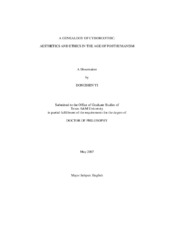| dc.description.abstract | This dissertation considers the future convergence between gothic studies and
humanism in the age of posthumanism and proposes “cyborgothic” as a new literary
genre that heralds that future. The convergence under consideration is already in
progress in that an encounter between human and non-human consistently inspires the
two fields, questioning the nature of humans and the treatment of such non-human
beings as cyborgs. Such questioning, often conducted within the boundary of humanities,
persistently interprets non-human beings as either representing or helping human
shortcomings. Accordingly, answers are human-orientated or even human-centered in
many cases, and “cyborgothic,” generated out of retrospective investigation into gothic
studies and prospective formulation of posthumanism, aims to present different, nonanthropocentric
ways to view humans and non-humans on equal terms.
The retrospective investigation into gothic studies focuses on Ann Radcliffe’s
The Mysteries of Udolpho and Edmund Burke’s A Philosophical Enquiry into the Sublime and Beautiful to retrieve a gothic aesthetics of the beautiful, and in the second
chapter, examines Mary Shelley’s Frankenstein against Kant’s aesthetics to demonstrate
how this gothic aesthetics becomes obsolete in the tradition of the sublime. This
dissertation then addresses Bram Stoker’s Dracula along with Bruno Latour’s Science in
Action to reveal problems in fabricating scientific knowledge, especially focusing on
sacrifices made in the process. In the forth chapter, I examine Sinclair Lewis’s
Arrowsmith with William James’s pragmatism, and consider the question of how moral
complications inherent in science have been handled in American society. The last
chapter proposes Marge Piercy’s He, She and It as a same cyborgothic text, which tries
to develop a way to acknowledge the presence of the cyborg—one that is at once
aesthetical and ethical—so as to enable humans and cyborgs to relate each other on
equal terms. Thus, “cyborgothic” is being required as a literary attempt to present the
age of posthumanism that is no longer anthropocentric. | en |


